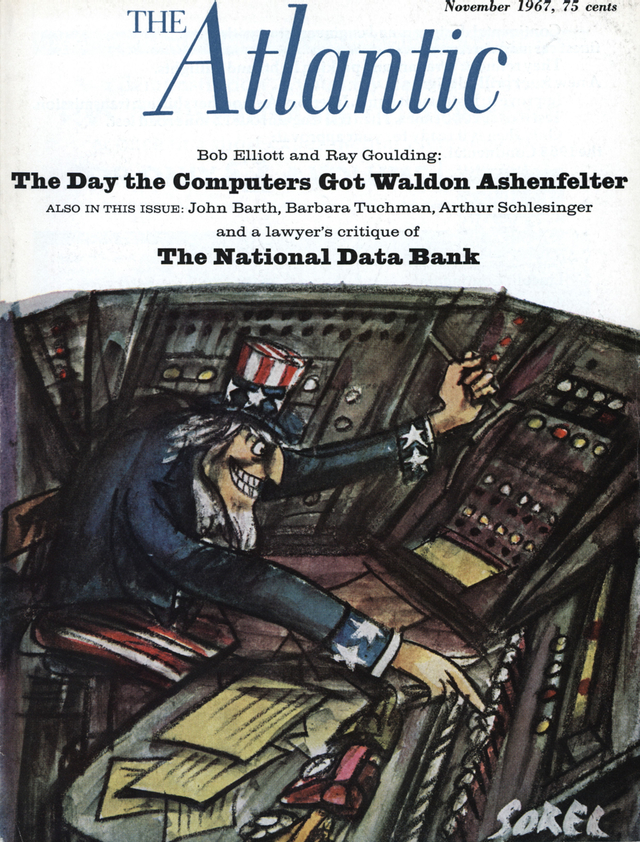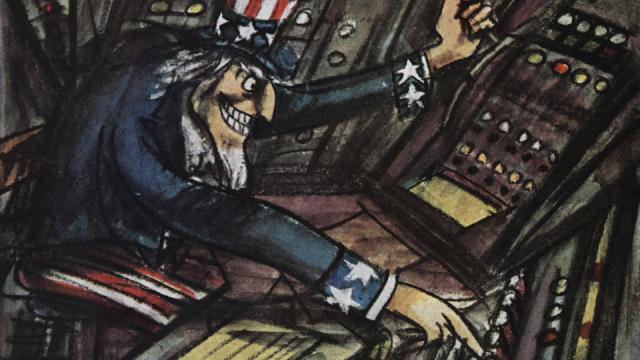Uncle Sam might soon be spying on you with a vast, computerised network. At least that was the eerie prophecy of The Atlantic in 1967.
In an article by Arthur Miller (a law professor at the University of Michigan, not the playwright) readers were introduced to the rise of centralized data collection, and how a futuristic data centre might be exploited in the future. Like, say, today.
Miller describes a dystopian world where computers can store vast amounts of personal, medical and financial data. He warns that while this information could prove incredibly useful, it could easily become vulnerable to nefarious entities in the government, private industry, or even individuals.
“Even the most innocuous of centres,” Miller writes, “could provide the ‘foot in the door’ for the development of an individualised computer-based federal snooping system.”
Back in 1967, the ARPANET — the precursor to the modern internet — was still two years away from making its first connection. But Miller foresaw the dangers of networked computing, an irresistible temptation for the development of a surveillance state by any tech-savvy government left unchecked by its people.
There are further dangers. The very existence of a National Data centre may encourage certain federal officials to engage in questionable surveillance tactics. For example, optical scanners — devices with the capacity to read a variety of type fonts or handwriting at fantastic rates of speed — could be used to monitor our mail. By linking scanners with a computer system, the information drawn in by the scanner would be converted into machine-readable form and transferred into the subject’s file in the National Data centre.
Miller’s vision of machines reading all our handwritten mail, while quaint, seems just as plausible given recent revelations by the FBI. However, it’s the automated monitoring of computer communications that resonates most for those of us here in the year 2013.
Miller’s image of a push-button surveillance state was creepy, but firmly planted in midcentury visions of tomorrow. Especially since push-buttons were supposed to be the liberators of humanity, freeing people to work smarter in the projected leisure society of the 21st century.
Then, with sophisticated programming, the dossiers of all of the surveillance subject’s correspondents could be produced at the touch of a button, and an appropriate entry — perhaps “associates with known criminals” — could be added to all of them. As a result, someone who simply exchanges Christmas cards with a person whose mail is being monitored might find himself under surveillance or might be turned down when he applies for a job with the government or requests a government grant or applies for some other governmental benefit. An untested, impersonal, and erroneous computer entry such as “associates with known criminals” has marked him, and he is helpless to rectify the situation. Indeed, it is likely that he would not even be aware that the entry existed.
These tactics, as well as the possibility of coupling wiretapping and computer processing, undoubtedly will be extremely attractive to overzealous law-enforcement officers. Similarly, the ability to transfer into the National Data centre quantities of information maintained in nonfederal files — credit ratings, educational information from schools and universities, local and state tax information, and medical records — will enable governmental snoopers to obtain data that they have no authority to secure on their own.
By the end of his article, Miller calls for legislation to protect the data of American citizens. Miller wasn’t the only one calling for privacy legislation around this time. The following year, Paul Armer of the RAND Corporation would testify in front of a Senate subcommittee raising some of the very same concerns about the emergence of a snooper society. In fact, I wouldn’t be surprised if Armer read Miller’s article.
Miller’s article appeared in the November 1967 issue of The Atlantic, nearly 50 years ago! But needless to say, that art could would fit in nicely with the newsstands of today. Just check out the latest issue of The New Yorker.
As best I can tell, Miller’s dystopian surveillance state without much in the way of due process is here. The only question that remains seems to be what the hell we can do about it.

Source: Charles Shopsin’s Modern Mechanix blog
